Published online by Cambridge University Press: 21 January 2019

The material and documentary archive of twentieth-century global conflict is rich and diverse, but even for such a recent period, gaps in our knowledge remain. One of these concerns abandoned Cold War military sites, where secrecy and historical silence surrounding their construction and use has limited our understanding. This article reports on research that combines airborne laser-scanning data, historical cartography, archived aerial photographs and declassified satellite imagery to investigate three Cold War nuclear storage sites in western Poland. The results supplement and challenge extant historical narratives, and demonstrate the potential of archaeological data for creating persuasive narratives about the recent hidden past.
To send this article to your Kindle, first ensure no-reply@cambridge.org is added to your Approved Personal Document E-mail List under your Personal Document Settings on the Manage Your Content and Devices page of your Amazon account. Then enter the ‘name’ part of your Kindle email address below. Find out more about sending to your Kindle. Find out more about saving to your Kindle.
Note you can select to save to either the @free.kindle.com or @kindle.com variations. ‘@free.kindle.com’ emails are free but can only be saved to your device when it is connected to wi-fi. ‘@kindle.com’ emails can be delivered even when you are not connected to wi-fi, but note that service fees apply.
Find out more about the Kindle Personal Document Service.
To save this article to your Dropbox account, please select one or more formats and confirm that you agree to abide by our usage policies. If this is the first time you used this feature, you will be asked to authorise Cambridge Core to connect with your Dropbox account. Find out more about saving content to Dropbox.
To save this article to your Google Drive account, please select one or more formats and confirm that you agree to abide by our usage policies. If this is the first time you used this feature, you will be asked to authorise Cambridge Core to connect with your Google Drive account. Find out more about saving content to Google Drive.